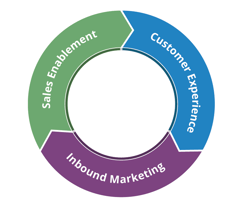In a digital marketing world where customers' attention is the end game, the winning brands tell the most compelling stories. Today’s audiences don’t just want marketing...they want meaning. And they don’t just want to be talked to...they want to see themselves reflected in your stories. That’s the power of digital storytelling done right. It doesn’t just inform, but it connects, inspires, and moves people to act. So, how do you cut through the noise, hold attention, and build trust, all in a few seconds? It starts with authenticity, emotion, and strategy.
We've gathered these 14 tips from industry leaders who’ve mastered the art of turning data, insight, and emotion into compelling digital stories that resonate with an audience.
- Start with Customer Reality
- Integrate Multimedia from the Beginning
- Create a Captivating Hook
- Balance Customer Insights with Emotions
- Leverage Your Unique Perspective
- Harness User-Generated Video Content
- Mirror Audience Communication Patterns
- Begin with One Authentic Voice
- Show the Future Impact
- Share Real-Life Customer Experiences
- Focus on What Customers Stop Doing
- Incorporate Interactive Real-Time Elements
- Make Your Audience the Hero
- Use Authentic Visuals to Connect
Start with Customer Reality
Start with what the audience already believes. Strong digital storytelling doesn't begin with the brand—it begins with the customer's reality. Use real data to understand what drives their decisions, what problems they face, and what moments matter most in their daily life. At MyVillage, we tracked parent concerns and behavioral patterns across our user base and uncovered one consistent theme: uncertainty about quality child care. That insight became the foundation for our most effective campaign, where we used video to share stories from parents and providers, grounded in hard numbers but driven by real emotion. The result was longer engagement, more shares, and stronger lead conversion.
Emotions drive memory, and data builds trust. Pairing both increases recall and loyalty. Start with research and translate it into authentic, emotionally resonant content. Avoid polish that makes the message feel manufactured.
Your job is to create a mirror, not a spotlight. Reflect your customer's lived experience to them using their language, not your brand's. Keep the tone human. The delivery is short. And the message is honest. When the story feels like theirs, they listen longer. When it feels like yours, they scroll.
Lisa Walthers, CMO, Upkid
Integrate Multimedia from the Beginning
Digital storytelling requires multimedia elements to be integrated as fundamental components. Create a story structure that includes visuals and multimedia elements from its inception rather than treating them as supplementary content after writing. This creates a more immersive and emotionally engaging experience that connects with your audience on multiple levels. At Recharge Health, we've seen how combining customer insights, data, and emotional storytelling into one cohesive narrative helps cut through the noise and build deeper brand loyalty.
Our campaign launch for the wearable light therapy device went beyond product specs by presenting a real user's journey with chronic pain management. We combined short video clips and data visualizations about its use with an insider look at the technology's science. The result was a story that informed and resonated with many people.
Even Fusdahl Hulleberg, Chief Marketing Officer, Recharge Health
Create a Captivating Hook
The best way to craft a compelling digital story is to create a good hook first. It must be snappy, to the point, and quickly capture people's interest. The hook can be anything, from a catchy font to a bombastic phrase or an interesting statistic. You want something that stands out from the crowd in the digital landscape, especially one where people's attention spans are scattered. The hook must grab them while maintaining the essence of your story because once you've attracted a few, more will gather. From there, the main thing to do is keep their attention; just as a clever mystery keeps you on the edge of your seat, you want the audience to talk about your story even after they've moved on.
Jessica Shee, Tech Editor & Marketing Manager, M3datarecovery.com
Balance Customer Insights with Emotions
One great way to create a digital story that people want to read is to base it on real customer insights and then bring it to life with data and emotions. That balance—between the head and the heart—cuts through the digital noise.
Start with a real customer situation, such as a problem, an idea, or a change. This makes your story authentic and relatable. Then, add emotions—not just what happened, but also how it made you feel. People care because they experience emotions. Finally, back it all up with facts that give it more weight and credibility. Use a powerful statistic or a surprising trend to demonstrate "why it matters," but don't let the data take the lead. Instead, let it support the emotional arc of the story.
For instance, don't say, "Our platform makes people 30% more productive." Instead, tell the story of a small team that was overwhelmed with administrative work and now completes jobs in half the time, with numbers to support it. Suddenly, it's not just a benefit. It's something you feel.
There is a lot of information out there, so the stories that stand out are the ones that feel genuine and deserved. To turn casual viewers into loyal brand advocates, you need to craft your message through the lens of a real person's journey, with facts to back it up and emotion to shape it.
Peter Wootton, SEO Consultant, The SEO Consultant Agency
Leverage Your Unique Perspective
One tip that has worked well for me is to lean into what makes your perspective unique and use that as the through-line.
The best digital stories don't try to sound like everyone else. They sound like you. On LinkedIn, I've seen the most traction when I share personal insights that connect to broader themes my audience cares about.
We're not data-driven; we're data-informed. This means we use metrics like brand impressions and engagement to guide direction, not dictate every move. If a post gets strong reactions or triggers conversation, we lean more into that tone or topic. However, we never let numbers strip the soul out of the story.
The loyalty comes from emotion and consistency. It's not about producing a perfect post once in a while, but about posting regularly. It's like building a muscle. Keep going until people start to recognize your voice and trust what you're saying.
Oz Rashid, Founder and CEO, MSH
Harness User-Generated Video Content
As a production company, we recommend leveraging user-generated video as a powerful tool for storytelling. UGC offers intimate glimpses into lives and perspectives that might otherwise remain unseen. This approach enables brands to connect authentically with audiences, showcasing real people and real stories that resonate on a deeper emotional level.
By utilizing user-generated content, we can give audiences an opportunity to see things from a perspective that's fresh and unfamiliar, often breaking away from the polished, highly controlled imagery that is typical of traditional advertising. These raw, unfiltered insights humanize the brand and foster trust by offering a genuine connection.
Ryan Stone, Founder & Creative Director, Lambda Video Production Company
Mirror Audience Communication Patterns
I pay close attention to how our audience naturally communicates online—things like their go-to emojis, slang, and even how they break up sentences. We track those patterns across reviews, Reddit threads, and comments, then use that same rhythm and tone in our storytelling.
One campaign opened with "lowkey obsessed with this," pulled straight from a customer's review, and it instantly resonated. Speaking in their language made the content feel like it came from their world, not just another brand trying to talk 'at' them. That shift deepened engagement and built real trust.
John Grant, Founder and CEO, Premier Bidets
Begin with One Authentic Voice
Start with one real voice. One person's experience builds immediate trust and clarity. Don't crowd the story with generalizations or branding language. Speak directly, plainly, and with proof. Digital noise fades when someone reads something that feels honest. Our work highlights a patient's journey, where they were, what changed, and what they did. That kind of story gives the audience a clear reference point and a reason to believe.
Once the story is grounded, use data to frame its relevance. Numbers validate emotion. For example, if someone used plant medicine to reduce prescription use, show the measurable drop. If people in a certain state face access barriers, quantify them. The more specific the insight, the more credible the story becomes. Data alone won't carry a message, but paired with a real person's account, it adds weight and structure to the story.
Keep the content direct. Cut filler. Avoid broad claims. Make it impossible for the reader to misunderstand who this is for, what happened, and why it matters. People scroll past brand messages because they sound like ads. People stop for a story that sounds like something real. That pause builds loyalty. And when they come back, they don't come back for the brand, they come back for more of what felt true.
Aspen Noonan, CEO, Elevate Holistics
Show the Future Impact
Recently, my marketing team pointed out something I hadn't considered: our campaigns often lack a conclusion. At first, I was taken aback. After all, our company isn't going anywhere anytime soon—we're thinking long-term, right? How can we even wrap up a narrative when the journey is ongoing?
But after hearing their perspective, I realized they had a valid point. To truly tap into the power of brand storytelling, we need to think about the future. Offering a "conclusion" doesn't mean closing the chapter on what we do. It's about showing the potential outcome—where the story leads when the customer or client engages with us. For instance, when we highlight the story of a candidate we've placed, it's powerful to show them succeeding in their role or even expanding their family as a result of newfound financial security.
Don't leave your audience hanging if you're telling the overarching story of your company's growth or a smaller narrative about a specific product or service. Every story needs a beginning, middle, and end that resonates emotionally and completes the journey for the people you're speaking to.
Ben Lamarche, General Manager, Lock Search Group
Share Real-Life Customer Experiences
Nothing builds trust and relatability like real voices from real people. When you highlight genuine customer stories, you turn benefits into real-life experiences that resonate emotionally with your audience.
How to do it:
- Identify impactful stories
Reach out to loyal customers or clients with positive experiences. Look for stories that reflect transformation, problem-solving, or emotional payoff.
- Use the customer’s voice
Let them speak in their own words—via video clips, quotes, or voiceovers. Authenticity is far more powerful than a scripted endorsement.
- Show the “before and after”
A compelling arc often involves a problem or challenge, how your product or service helped, and the result. Frame it like a mini-journey.
- Add visuals that support the story
Use real photos, short interview clips, behind-the-scenes shots, or social media posts. Bonus: include footage of the customer using your product or interacting with your team.
- Make it emotional
Focus on how your brand impacted the customer’s life, not just the features. Did it save them time? Reduce stress? Open new possibilities?
Rich Meyer, VP of Marketing, Prism Global Marketing Solutions
Focus on What Customers Stop Doing
I started leaning into what I call "negative space" storytelling—where the story isn't built around what customers are doing, but what they've 'stopped' doing. We pulled data on canceled subscriptions, unused features, and even locations they no longer check into. Then we crafted narratives around that quiet shift.
For example, instead of saying "our app boosted productivity," we showed how users no longer needed late-night work sessions or extra tools. That absence spoke volumes. Framing change through what's been let go, not just adopted, created a deeper emotional connection and sparked more thoughtful engagement.
John Elarde III, Operations Manager, Clear View Building Services
Incorporate Interactive Real-Time Elements
I recommend incorporating "real-time" storytelling through interactive content to craft a compelling digital story. Traditional static content can only go so far in engaging your audience, but by using tools like live polls, real-time voting, or user-generated input, you can let your audience shape the narrative as it unfolds. This makes the story feel more personal and dynamic, with your brand reacting in real-time to audience feedback.
What's great about this approach is that it creates a sense of shared ownership—your audience feels like they're an integral part of the story. Layering in emotional triggers during this process helps strengthen the bond between your brand and the audience, turning passive viewers into active participants.
Jeffrey Zhou, CEO & Founder, Fig Loans
Make Your Audience the Hero
Typically, stories follow a hero's journey, where the brand saves the day. However, consider flipping this structure in digital storytelling by making your audience the hero and your product the sidekick or enabler. This change in narrative allows your audience to feel empowered, positioning them at the story's center. You can use customer-driven data to highlight how your product has transformed their experiences or solved their challenges. When your audience recognizes their own journey reflected through your product, it fosters a deeper emotional connection and strengthens brand loyalty.
Lacey Jarvis, COO, AAA State of Play
Use Authentic Visuals to Connect
People connect with stories when they can see themselves in them, and you need solid visuals to achieve this, not stock images or generative AI, but photography and videos created by your brand. Yes, a lot of brands are taking the easy way out with AI-generated imagery, but it doesn't help in the long run. Real projects and real outcomes—that's what people want to see.
We use a lot of behind-the-scenes footage, project shots, and walkthroughs showing real schools, councils, and community spaces before and after we build. It just helps buyers imagine what's possible in their own environment, and that's the moment they start moving from interest to action.
Gerry Wallace, Managing Director, Greenline
The most effective digital stories are grounded in authenticity. They start with the customer's reality, not the brand’s agenda. They balance emotion with evidence. They feel personal, not polished.
Whether you're using user-generated video, interactive elements, or patient testimonials, the goal is the same: build trust by reflecting the world as your audience sees and feels it. Show them their own hopes, challenges, and wins through your lens. Make them the hero. Use real visuals, real data, and real voices to guide them forward. And always finish the journey by showing them what life looks like on the other side.
Because when your story feels real, it earns attention. And when it feels like their story, it earns their loyalty.
If you're interested in discussing ways to create more compelling digital stories at your company, we invite you to schedule an inbound marketing consultation with our team.


.png?width=80&height=80&name=diamond-badge-color%20(1).png)
__Square.png?width=250&height=250&name=Marketing_Hub_(1)__Square.png)




.png?width=250&name=diamond-badge-color%20(1).png)
